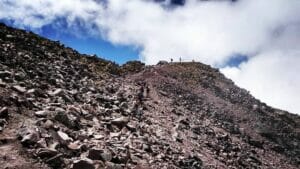Matlalcueye in Nahuatl
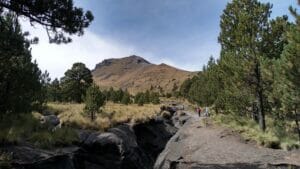
Mt. Matlalcueye – What kind of mountain is it?
Originally known as “Matlalcueye,” written in Nahuatl, it means “Blue Skirted God” and symbolizes fertility in cities like Tlaxcala and Cholula.
Mount Matlalcueye is located approximately 150 kilometers to the west of Mexico City. You can drive up to an altitude of about 3000 meters to reach the starting point of the climb. The elevation difference from the base to the summit is around 1400 meters, similar to the distance from Mount Fuji’s 5th station to its summit. The ascent takes about 5 hours at a leisurely pace, while the descent takes around 3 hours, making it an 8-hour trip.
The difficulty level of the climbing route is not extremely high, but the climb from an altitude of 3000m to over 4000m with a vertical ascent of 1400m and the extended duration of the route require considerable physical endurance. There are no mountain huts or toilets along the way. Additionally, at an altitude above 4000m, there are sections with hundreds of meters of rocky terrain just before reaching the summit. As such, this climb is only recommended for experienced climbers.
For a safe and enjoyable climbing experience on Mount Matlalcueye
If you are coming from lower altitudes, we recommend engaging in activities such as running in Mexico City at an altitude of 2200m to acclimate your body to higher elevations.
Our recommended tour route often involves acclimatizing at an altitude of 4000-4500m on the previous day with a light hike or short climb on Iztaccihuatl mountain, followed by an overnight stay in Uamantla at the base of Mount Matlalcueye. The ascent of Mount Matlalcueye typically starts around 7:30 am on the following day.
For those who participate in the 10-hour tour to reach an altitude of 5000m on Iztaccihuatl mountain, we suggest allowing an extra day for rest and recovery.
Your guide, Mr. Iwazaki, will bring water, a stove, a pot, and freshly ground coffee, so you can enjoy delicious Mexican coffee at the summit! If you bring water, you can also cook instant noodles and other food items.
It is possible to do a day trip from Mexico City, but please note that it takes around 16 hours from hotel departure to return. If the tour exceeds 12 hours, additional fees will apply. For more details, please refer to “Rates and Services” on our website.
Certified guides approved by the Mexican Ministry of Tourism will accompany you
Our guides hold a NOM-09-TUR-2002 license from the Mexican Ministry of Tourism, which includes training in primary first aid (for bleeding, open fractures, closed fractures, sprains, CPR, and airway obstruction) in remote natural environments (updated every 2 years). In the event of an accident, they can provide necessary emergency measures until medical personnel arrive.
Additionally, to ensure communication in mountain areas where cell phones may not work, we have a system in place to enable radio communication with our personnel at the base (trained in primary first aid). For groups of more than four people, we also provide sub-guides (tourism ministry-certified guides) to accompany the climb.
Our top priority is to provide our customers with a safe and enjoyable climbing experience. However, we must not forget that climbing is a risky activity involving nature. Participants should carefully consider their own physical fitness, health, and experience and take responsibility for their own participation. We recommend checking the coverage of any insurance policies obtained in Japan, as some policies may not apply to mountain climbing or may not cover accidents above a certain altitude. If desired, we can provide information on Mexican insurance, but please note that such coverage typically extends only up to an altitude of 3500m. There are currently no insurance products that provide coverage for altitudes above 3500m.
In case of adverse weather conditions or the possibility of rain, and in the event of injury or illness to any participant, we may decide to suspend the tour and descend for the safety of our customers. We recommend engaging in physical activities, such as running, in Mexico City at an altitude of 2200m to acclimatize. Due to the high altitude, it can be quite chilly even in the summer, so please prepare warm clothing.
Photo Gallery
Left: Popocatepetl, the 2nd highest peak in Mexico. Right: Iztaccihuatl, the 3rd highest peak.
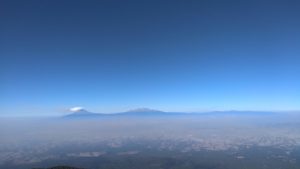
Mexico’s highest peak, Citlaltepetl (5636m)
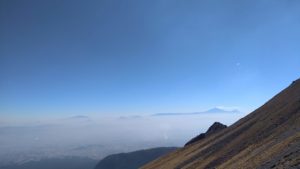
Ridge before reaching the summit
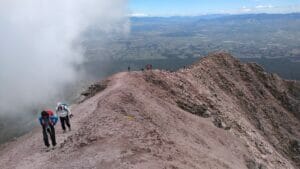
The final rocky section before the summit
